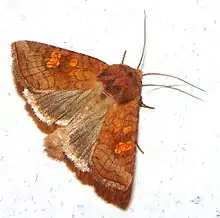Amphipoea lucens
Amphipoea lucens, the large ear or large ear moth, is a moth of the family Noctuidae. It was first described by Christian Friedrich Freyer in 1845 and it is found in most of Europe.
| Amphipoea lucens | |
|---|---|
 | |
 | |
| Scientific classification | |
| Kingdom: | |
| Phylum: | |
| Class: | |
| Order: | |
| Family: | |
| Genus: | |
| Species: | A. lucens |
| Binomial name | |
| Amphipoea lucens (Freyer, 1845) | |
| Synonyms | |
| |
the wingspan is about 30–36 mm. It resembles Amphipoea oculea, but is larger, and with the ground colour, as a rule, pale and the reniform white.
Adults are on wing from August to September.
The larvae feed on the roots and stem bases of various grasses, especially Molinia caerulea.[1]
Similar species
Requiring genitalic examination to separate,
References
- Robinson, Gaden S.; Ackery, Phillip R.; Kitching, Ian J.; Beccaloni, George W.; Hernández, Luis M. "Search the database - introduction and help". HOSTS - A Database of the World's Lepidopteran Hostplants. Natural History Museum, London.
External links
- Kimber, Ian. "73.127 BF2357 Large Ear Amphipoea lucens (Freyer, 1845)". UKMoths. Retrieved 28 June 2019.
- Savela, Markku. "Amphipoea lucens (Freyer, 1845)". Lepidoptera and Some Other Life Forms. Retrieved June 28, 2019. Taxonomy
- Lepiforum e.V. Includes photo of genitalia
- De Vlinderstichting (in Dutch)
This article is issued from Wikipedia. The text is licensed under Creative Commons - Attribution - Sharealike. Additional terms may apply for the media files.